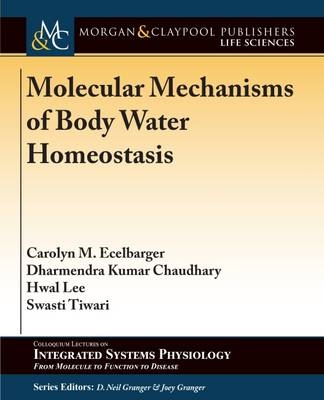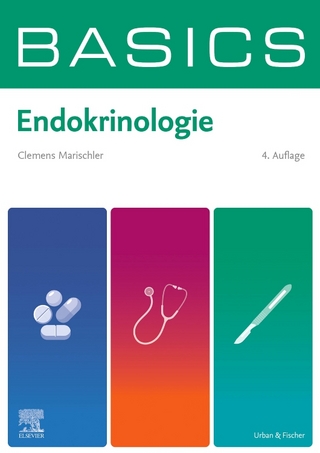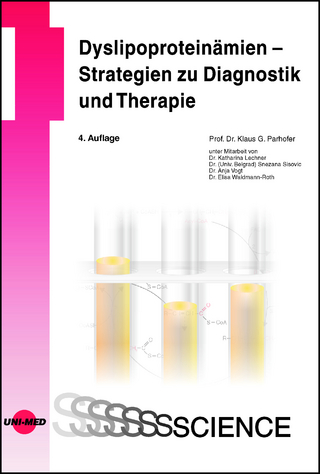
Molecular Mechanisms of Body Water Homeostasis
Seiten
2016
Morgan & Claypool Publishers (Verlag)
978-1-61504-732-1 (ISBN)
Morgan & Claypool Publishers (Verlag)
978-1-61504-732-1 (ISBN)
Discusses our intimate relationship with and dependence on water, how the body regulates its water levels, and various pathophysiological states associated with impairments in body water homeostasis. The human body consists of 70-80% water. Therefore, concise control of water homeostasis is essential to survival and involves coordination of several systems.
This book discusses our intimate relationship with and dependence on water, how the body regulates its water levels, and various pathophysiological states associated with impairments in body water homeostasis. The human body consists of 70–80% water. Therefore, concise control of water homeostasis is essential to survival and involves coordination of several systems, but primarily the brain and kidney systems. Water requirements of the average healthy human range between 2–4 L/d, and a major portion of this can come from food sources. The major hormonal regulator of water balance is the anti-diuretic hormone, vasopressin. Vasopressin, a 9–amino acid peptide, is produced in the hypothalamus, stored in the posterior pituitary, and secreted when plasma osmolality rises. Vasopressin acts on the kidney to conserve water. The kidneys filter ∼180 L of blood per day, consisting of about 50–65% water, and reabsorb around 99% of this in the proximal tubule, distal tubule, and collecting duct, producing only 1–2 L of urine. The vasopressin-sensitive distal tubule and collecting duct are responsible for fine-tuning water reabsorption. Conditions exist, however, where urine cannot be concentrated effectively. This is known as diabetes insipidus and can lead to dehydration and failure to thrive. At the other extreme, hyponatremia (low serum sodium) is the inability to adequately dilute urine or get rid of free body water in excess of body needs, a serious and sometimes fatal condition.
This book discusses our intimate relationship with and dependence on water, how the body regulates its water levels, and various pathophysiological states associated with impairments in body water homeostasis. The human body consists of 70–80% water. Therefore, concise control of water homeostasis is essential to survival and involves coordination of several systems, but primarily the brain and kidney systems. Water requirements of the average healthy human range between 2–4 L/d, and a major portion of this can come from food sources. The major hormonal regulator of water balance is the anti-diuretic hormone, vasopressin. Vasopressin, a 9–amino acid peptide, is produced in the hypothalamus, stored in the posterior pituitary, and secreted when plasma osmolality rises. Vasopressin acts on the kidney to conserve water. The kidneys filter ∼180 L of blood per day, consisting of about 50–65% water, and reabsorb around 99% of this in the proximal tubule, distal tubule, and collecting duct, producing only 1–2 L of urine. The vasopressin-sensitive distal tubule and collecting duct are responsible for fine-tuning water reabsorption. Conditions exist, however, where urine cannot be concentrated effectively. This is known as diabetes insipidus and can lead to dehydration and failure to thrive. At the other extreme, hyponatremia (low serum sodium) is the inability to adequately dilute urine or get rid of free body water in excess of body needs, a serious and sometimes fatal condition.
Department of Medicine, Division of Endocrinology and Metabolism, Georgetown University, Washington, DC 20007 Department of Molecular Medicine & Biotechnology, Sanjay Gandhi PGI, Lucknow-226014, India, Department of Medicine Department of Medicine, Division of Endocrinology and Metabolism, Georgetown University, Washington, DC 20007 Department of Molecular Medicine & Biotechnology, Sanjay Gandhi PGI, Lucknow-226014, India, Department of Medicine
Water, Water Everywhere
The Brain, AVP, and Water Balance
Renal Control of Water Reabsorption
Hyponatremia
Diabetes Insipidus
Additional Pathophysiological States Associated with Impaired Water Balance
References
Author Biographies
| Erscheinungsdatum | 03.12.2016 |
|---|---|
| Reihe/Serie | Colloquium Series on Integrated Systems Physiology: From Molecule to Function |
| Verlagsort | San Rafael |
| Sprache | englisch |
| Maße | 191 x 235 mm |
| Gewicht | 220 g |
| Themenwelt | Medizinische Fachgebiete ► Innere Medizin ► Endokrinologie |
| Studium ► 1. Studienabschnitt (Vorklinik) ► Biochemie / Molekularbiologie | |
| Studium ► 1. Studienabschnitt (Vorklinik) ► Physiologie | |
| ISBN-10 | 1-61504-732-8 / 1615047328 |
| ISBN-13 | 978-1-61504-732-1 / 9781615047321 |
| Zustand | Neuware |
| Haben Sie eine Frage zum Produkt? |
Mehr entdecken
aus dem Bereich
aus dem Bereich
Buch | Hardcover (2023)
UNI-MED (Verlag)
CHF 55,70


